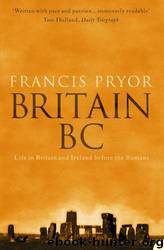Britain BC by Francis Pryor

Author:Francis Pryor
Language: eng
Format: epub, mobi
Publisher: HarperCollins Publishers
Published: 2015-02-10T16:00:00+00:00
I well recall the first time I saw the Orkney Islands. I was on that trawler I wrote about in Chapter 5, and we were steaming north towards the Pentland Firth in a Force 9 gale. Off our port side I could see the headland of John o’Groats, and to starboard the intricate, treeless coastline of the Orkney island of South Ronaldsay was beginning to emerge through the spume. For a moment the storm abated; but it was only a pause, as if to draw a deep breath. As we entered the firth the wind grew stronger and stronger, while at the same time the waves dropped, and the sea hissed and seethed like water boiling in a cauldron. Instead of rising and falling, the ship’s bows were caught by conflicting currents, and she juddered and yawed unpredictably from side to side. It was a terrifying experience for a landlubber, and one that I’ll never forget.
It could be argued that Orkney is the most exciting prehistoric site in north-western Europe. Everything is there, and what’s more, it’s superbly preserved. There are many reasons for the fine preservation, but the fact that the sites and monuments are so magnificent in the first place cannot be explained so readily. As I steamed past the islands towards Iceland, I didn’t know that Orkney’s lack of trees was more than compensated for by the superb local stone, that cleaves, splits and behaves like timber. This is undoubtedly one of the main reasons why the ancient sites of the islands have survived so well for so long. And of course their remoteness has helped protect them from subsequent abuse. Maybe too their location, on the extreme edge of mainland Britain, gave them a very special sort of liminality that had appeal beyond the immediate confines of the islands.
The literature on Orcadian prehistory is vast,21 but Anna Ritchie has written an excellent overview for the general reader.22 However, no book can substitute for the real thing: the megalithic tombs of Orkney almost defy description, and that at Maes Howe actually does. It’s a passage grave beneath a great mound and with a corbelled burial chamber – not dissimilar in general plan to those of Ireland. But that’s where the similarity ends. The masonry at Maes Howe is as near perfect as it’s possible to get without the use of mortar. If one did not know that the passage had been constructed five thousand years ago, one could easily imagine it to be the work of Victorian masons working with modern tools and lifting equipment. The burial chamber rivals anything in Neolithic Europe. It has a powerful acoustic that seems somehow to magnify, and not just echo, sound. This has been studied by Aaron Watson, who concluded that ‘the precise joining of the dry-stone walling creates a virtually unbroken surface from which sound can reflect. For this reason, sounds within this resonant cavity are heard quite differently, appearing fuller and louder.’23 Watson is in no doubt that
Download
This site does not store any files on its server. We only index and link to content provided by other sites. Please contact the content providers to delete copyright contents if any and email us, we'll remove relevant links or contents immediately.
The Daily Stoic by Holiday Ryan & Hanselman Stephen(3109)
The Fate of Rome: Climate, Disease, and the End of an Empire (The Princeton History of the Ancient World) by Kyle Harper(2870)
People of the Earth: An Introduction to World Prehistory by Dr. Brian Fagan & Nadia Durrani(2619)
Ancient Worlds by Michael Scott(2492)
Babylon's Ark by Lawrence Anthony(2429)
Foreign Devils on the Silk Road: The Search for the Lost Treasures of Central Asia by Peter Hopkirk(2387)
The Daily Stoic by Ryan Holiday & Stephen Hanselman(2343)
India's Ancient Past by R.S. Sharma(2295)
MOSES THE EGYPTIAN by Jan Assmann(2275)
The Complete Dead Sea Scrolls in English (7th Edition) (Penguin Classics) by Geza Vermes(2135)
Lost Technologies of Ancient Egypt by Christopher Dunn(2110)
The Earth Chronicles Handbook by Zecharia Sitchin(2100)
24 Hours in Ancient Rome by Philip Matyszak(1973)
Alexander the Great by Philip Freeman(1960)
Aztec by Gary Jennings(1877)
The Nine Waves of Creation by Carl Johan Calleman(1783)
Curse Tablets and Binding Spells from the Ancient World by Gager John G.;(1768)
Before Atlantis by Frank Joseph(1740)
Earthmare: The Lost Book of Wars by Cergat(1715)
